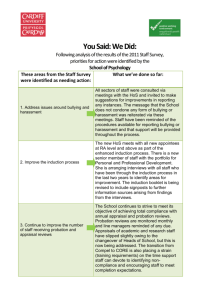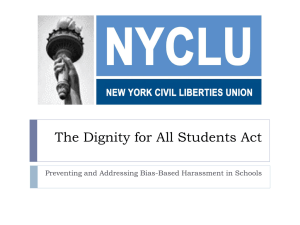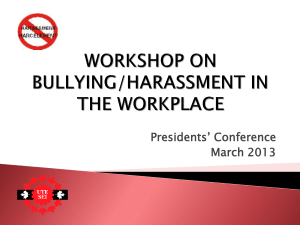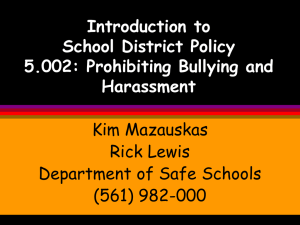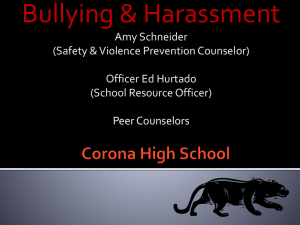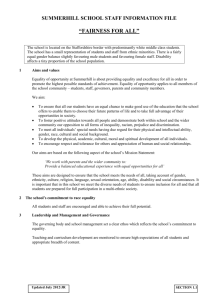Bullying and Harassment Policy Approved
advertisement
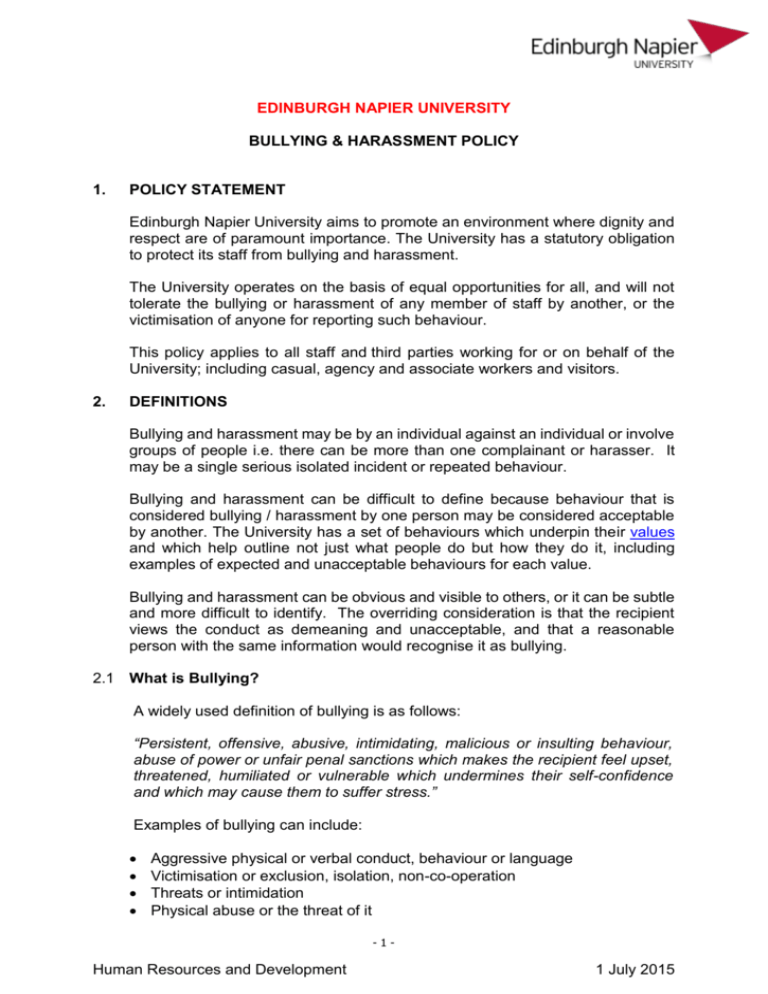
EDINBURGH NAPIER UNIVERSITY BULLYING & HARASSMENT POLICY 1. POLICY STATEMENT Edinburgh Napier University aims to promote an environment where dignity and respect are of paramount importance. The University has a statutory obligation to protect its staff from bullying and harassment. The University operates on the basis of equal opportunities for all, and will not tolerate the bullying or harassment of any member of staff by another, or the victimisation of anyone for reporting such behaviour. This policy applies to all staff and third parties working for or on behalf of the University; including casual, agency and associate workers and visitors. 2. DEFINITIONS Bullying and harassment may be by an individual against an individual or involve groups of people i.e. there can be more than one complainant or harasser. It may be a single serious isolated incident or repeated behaviour. Bullying and harassment can be difficult to define because behaviour that is considered bullying / harassment by one person may be considered acceptable by another. The University has a set of behaviours which underpin their values and which help outline not just what people do but how they do it, including examples of expected and unacceptable behaviours for each value. Bullying and harassment can be obvious and visible to others, or it can be subtle and more difficult to identify. The overriding consideration is that the recipient views the conduct as demeaning and unacceptable, and that a reasonable person with the same information would recognise it as bullying. 2.1 What is Bullying? A widely used definition of bullying is as follows: “Persistent, offensive, abusive, intimidating, malicious or insulting behaviour, abuse of power or unfair penal sanctions which makes the recipient feel upset, threatened, humiliated or vulnerable which undermines their self-confidence and which may cause them to suffer stress.” Examples of bullying can include: Aggressive physical or verbal conduct, behaviour or language Victimisation or exclusion, isolation, non-co-operation Threats or intimidation Physical abuse or the threat of it -1- Human Resources and Development 1 July 2015 Humiliation or ridicule, in front of others or in private including the use of words, phrases or nicknames that may lead to humiliation or ridicule, or ‘outing’ of a person’s status Unreasonable refusal to delegate authority or responsibility, for instance, overbearing supervision or other misuse of power or position. Deliberately undermining a competent employee / student with constant criticism, setting them up to fail, overloading with work, removing responsibilities or imposing impossible deadlines Unwelcome sexual advances – touching, standing too close, the display of offensive materials, asking for sexual favours, making decisions on the basis of sexual advances being accepted or rejected Spreading malicious rumours, or insulting someone verbally or through behaviour Treating someone less favourably because of their age, disability, gender reassignment, marriage and civil partnership, pregnancy and maternity, race, religion and belief, sex, sexual orientation (as per the Equality Act). Copying emails, memos etc. that are critical about someone to others who do not need to know; Making threats or comments about job security without foundation; Preventing individuals progressing by intentionally blocking promotion or training opportunities. These examples of bullying are not exhaustive. Other aspects of conduct or behaviour which undermine the dignity of staff or students may also be deemed to be bullying. Bullying behaviour can be done through a variety of mediums i.e. face to face, in writing, by phone or through social media content. 2.2 What is Harassment? In general terms, harassment can be defined as unacceptable behaviour which subjects the recipient(s) to unwelcome attention, intimidation, humiliation, ridicule, offence or loss of privacy. In many cases harassment may be related to, the strands covered by the Equality Act as detailed above, or another personal characteristics of an individual. Examples of harassment include: Sexist or racist “jokes”, derogatory comments, belittling remarks, ridicule, insults or verbal abuse relating to an individual’s personal characteristics; Any comments implying that age, disability, gender reassignment, marriage and civil partnership, pregnancy and maternity, race, religion and belief, sex, sexual orientation (as per the Equality Act)or any other irrelevant factor impairs a person’s ability to do their job; Propositions; unwanted sexual advances; demands for sexual favours; leering; innuendo; Unwanted physical contact, ranging from invasion of personal space to assault or rape; Displaying offensive material such as pornographic, sectarian, racist or other demeaning images; Human Resources and Development 1 July 2015 2 Displaying offensive material or sending it electronically; Mimicking a disability or any other characteristic of an individual; Deliberate isolation or less favourable treatment. These examples of harassment are not exhaustive. Other aspects of conduct or behaviour which undermine the dignity of staff or students may also be deemed to be bullying. Harassment can be done through a variety of ways i.e. face to face, in writing, by phone or through social media content. As well as being unacceptable in terms of Edinburgh Napier University Policy, certain types of harassment may constitute a criminal offence, with legal implications for the perpetrator and the University. 3. INFORMAL ACTION Prior to raising a formal complaint, consideration should be had as to whether the behaviour could be stopped informally by approaching the individual, telling them that their behaviour is unacceptable and that you want it to stop. Some people may not realise the effect their behaviour is having on others and will stop when requested. If you feel unable to raise your concerns with the person / group directly, consider writing to them stating that you feel bullied and / or harassed, state where and when this occurred and how you wish to be treated. It should be made clear to the alleged harasser that if their conduct / behaviour continues, you may raise a formal grievance. It is important to keep notes of incidents, times, dates, places and the names of any witnesses, if any. Always keep a copy of all evidence and any written documentation / communications. Early action by management Managers also have a duty to proactively manage their environment to prevent bullying and/or harassment developing in their area. They are also expected to act promptly and to intervene early when behaviours that could indicate bullying and/or harassment are suspected. In particular Managers; • • Must deal with the situation as soon as is practical. • Always meet with the member of staff to discuss the issue or meet with the members of staff if there is more than one person involved separately, to discuss the issue • Agree any actions such as apologies, training to be undertaken or advice regarding the requirements of their job • Provide timely feedback to staff as appropriate Human Resources and Development 1 July 2015 3 • Make a note of the incident, actions and conclusions and email it to all concerned parties • Monitor the situation ensuring actions are carried out 4. FORMAL ACTION If the informal route is unsuccessful, or the matter is too serious to be resolved this way, you should make a formal written complaint. Allegations of bullying and / or harassment are handled through the University’s Grievance Policy and Procedure and where an allegation is proved, the University’s Disciplinary Policy and Procedure will be instigated. You can request that contact arrangements between yourself and the alleged harasser / bully to be minimised until the investigation is complete. Any one-toone meetings / contacts may be stopped during this period, if deemed appropriate. Reasonable changes to office accommodation may also be considered. It may be deemed necessary to suspend the alleged harasser, without prejudice, this would be done in line with the University’s Disciplinary Policy. Please be aware that the alleged harasser or bully also has rights to a fair investigation and confidentiality. You must not discuss your case with other employees, unless they are witnesses to the event(s) and you are obtaining evidence from them, a failure to maintain confidentiality may result in disciplinary action being taken against you. Please be aware that any false or malicious accusations or allegations will result in a formal investigation and result in possible disciplinary action being taken against the person making the false allegation/s. The University is aware that making a complaint can be unsettling, please be aware that you can request a referral to the University’s Occupational Health Provider and you can contact the University’s Employee Assistance Provider for confidential support / advice and counselling, and see Appendix A. 5. What to do if you are accused of Bullying or Harassment 5.1 Informal If someone approaches you informally about your behaviour at work it may be because you are unaware of how it affects other people. You should consider whether your behaviour meets the expectations outlined in the University values and behaviours. You may mean well, but if your behaviour causes distress to another person, they have the right to let you know, and to ask you to stop. If this happens, you should think about the possibility that you may be at fault and try not to be defensive or aggressive at the suggestion. Try to resolve the problem. An informal discussion with the person concerned, or conciliation by a colleague you both trust, can be effective. Human Resources and Development 1 July 2015 4 5.2 Formal If the complaint is progressed formally, you will be invited to a formal investigation meeting. You will be provided with information about the nature of the complaint against you within the invite letter and at the formal investigation meeting you will be given the opportunity to respond to these allegations. You have the right to be accompanied to any formal meetings you are invited to attend as part of the University’s Grievance Procedure. You will be notified in writing of the outcome of the process. If the Grievance is upheld this may result in disciplinary action being taken against you. However, a range of outcomes are available to a disciplinary panel. Please refer to the University’s Disciplinary Policy and Procedure. Human Resources and Development 1 July 2015 5 Appendix A SUPPORT AVAILABLE Occupational Health Service – Health Management Ltd. Any member of staff who is involved in a claim of bullying and harassment and would like to speak to our independent Occupational Health service, please request a management referral from your Line Manager. Employee Assistance Provider – Workplace Options The University’s Employee Assistance Provider is Workplace Options who provide a free, confidential and independent resource to help employees balance their work, family and personal lives. The service is available 24 hours a day, 7 days a week, and 365 days a year. Workplace Options can be contacted by phone (0800 243 458), email or online. There is also an extensive range of online documentation available on their website, more information about Workplace Options can be found in the EAP Section of the HR Intranet Site. By contacting Workplace Options, through their free phone number, access can be gained to telephone counselling (up to 6 sessions), face to face counselling (up to 6 sessions) and the information service. These services are available to both employees and their immediate family members. Trade Union Representatives There are elected trade union representatives across the University from different trade unions representing the interests of different groups of staff. Edinburgh Napier University recognises the important role trade union representatives play in addressing bullying and harassment in the work environment. The trade unions are skilled in dealing sensitively and practically, both formally and informally, with harassment and bullying issues and the University will work in conjunction with the trade unions to address unacceptable and inappropriate behaviours as quickly and fairly as possible. UNISON: http://staff.napier.ac.uk/groups/UNISON/Pages/UNISON.aspx EIS-ULA: http://staff.napier.ac.uk/groups/eis-ula/Pages/EIS-ULA.aspx Human Resources and Development You can contact your designated HR Client Partner for advice and support, especially in relation to process. Human Resources and Development 1 July 2015 6


